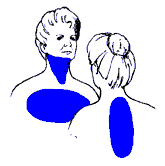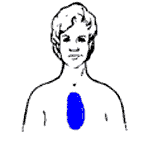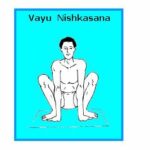Heart Attack / Angina pain / Coronary Heart disease
WHAT IS HEART ATTACK ?
Heart is one of the most important organs of the body supplying blood to all parts of the body. In turn heart by itself gets nourishment through the blood in the carotid arteries on its surface. Any narrowing or blockage in these arteries results in reduced flow of blood to the heart itself leading to heart stress. When arteries are narrowed in excess of 90 to 99%, patients often have accelerated angina or angina at rest (unstable angina). Unstable angina can also occur due to intermittent blockage of an artery by a thrombus that eventually is dissolved by the body’s own protective clot-dissolving system. CAD is known as a lifestyle disease since its onset is mostly linked to faulty lifestyle practices.
The first hour of a heart attack is known as the “golden hour.” If you get help during that first hour, your chances of recovery are greatly improved. Yet many people hesitate to get help when they first experience symptoms. They’re afraid of the embarrassment of going to the emergency room and finding that nothing is wrong. So, it is important that you know the symptoms that may indicate that a heart attack is in progress.
Many of the symptoms of heart attack can be brought on by digestive disturbances or other less serious conditions. But only sophisticated medical tests can determine for sure if you’re having a heart attack. Heart attacks may vary from person to person, and from heart attack to heart attack. Women, for example, may experience “atypical’ symptoms such as pain between the shoulder blades rather than crushing chest pain. This may result in them delaying seeking treatment. That is a great mistake.
HEART ATTACK IS ONE INSTANCE WHERE GETTING TREATMENT PROMPTLY CAN MEAN THE DIFFERENCE BETWEEN LIFE AND DEATH. IF YOU ARE IN DOUBT, ERR ON THE SIDE OF BEING MORE CAUTIOUS AND GO TO THE EMERGENCY ROOM AND GET YOURSELF CHECKED.
ANGINA
Angina pectoris is a precursor to a heart attack. The plaque deposit in the arteries or results of old age causes significant narrowing of the coronary arteries resulting in reduced blood supply. When this blockage crosses 50 to 70%, the blood supply beyond these points is not enough to meet the increased oxygen demand during exercise. As a result the heart muscle getting supply from these arteries becomes starved of oxygen and becomes ISCHEMIC.
During physical exertion, during stress or an emotionally charged situation, in cold weather or after a big meal, the heart beats faster. Heart requires more oxygenated blood flow to the heart muscle to maintain the beating. But if the channels by which the blood and oxygen flow to the heart are narrowed, not enough nutrients get to the heart muscle tissue. When blood oxygen supply can not match the demand, the individual experiences CHEST PAIN (ANGINA) and the heart tells you about this with a pain called angina pectoris.
This is generally a warning sign and the pain usually disappears at rest.
The pain is quite distinct. It is described as: “a heavy, strangulating, suffocating experience-far more intense than anything like indigestion, chest wall injuries, pleurisy or spasms of the esophagus that you are familiar with. The pain may seem to start under the breastbone, on the left side of the chest, and sometimes radiates out to other places: throat, neck, jaw, left shoulder and arm and, occasionally, on to the right side.
Angina is an intense, scary episode. But with rest and calm (or by placing nitroglycerin or another kind of nitrate-Sorbitrate under the tongue), angina attacks usually go away in about 15 minutes or so. If they last longer than that, go to the hospital and have a thorough check up. Long-lasting angina attacks may be the prelude to heart attacks.
The statistics show that half of those with angina pectoris suffer sudden deaths, a third have heart attacks, and most victims are older men. And an estimated 350,000 new cases of angina occur each year.
Although you may not appreciate it when you are suffering from pain, angina itself is not bad. In fact it may be a blessing! Some doctors call angina “God’s gift to humans” because many heart problems are silent, without symptoms, and go unnoticed until they become the cause of sudden death. Angina is an early warning sign that something is wrong. Its presence may help identify those at risk of heart attack so that you can seek proper medical treatment promptly.
WHAT IS “GOLDEN HOUR” IN HEART ATTACK?
The first hour of a heart attack is known as the “golden hour.” If you get help during that first hour, your chances of recovery are greatly improved. Yet many people hesitate to get help when they first experience symptoms. They’re afraid of the embarrassment of going to the emergency room and finding that nothing is wrong. So, it is important that you know the symptoms that may indicate that a heart attack is in progress.
Many of the symptoms of heart attack can be brought on by digestive disturbances or other less serious conditions. But only sophisticated medical tests can determine for sure if you’re having a heart attack. Heart attacks may vary from person to person, and from heart attack to heart attack. Women, for example, may experience “atypical’ symptoms such as pain between the shoulder blades rather than crushing chest pain. This may result in them delaying seeking treatment. That is a great mistake.
Heart attack is one instance where getting treatment promptly can mean the difference between life and death. If you are in doubt, err on the side of being more cautious and go to the emergency room and get yourself checked. We will try to describe some of the most common characteristics of heart attack here. Before that we will introduce the other pain called angina which is often precursor to a heart attack.
SYMPTOMS OF ANGINA PAIN
- Most of the times a patient mistakes the angina pain as a gastric disorder. Angina pain / heart attack symptoms are, however, typically different from any other illness. These are:
- Chest pain radiating to the left shoulder or at times both shoulders and to the neck and face also. This pain may occur on exertion and eases with rest.
- Chest pain brought about by emotional stress.
- Pain lasting for up to 15 minutes or more and may or may not disappear on resting.
- New or unusual shortness of breath / Breathlessness. For example if you suddenly feel breathless after climbing a few stairs when you could climb the same or more number of stirs in one go earlier.
- Unusual indigestion – especially if you feel its onset unrelated to food intake.
- Giddiness.
- Nausea.
HEART ATTACK
Gradually the arteries develop blockages up to 100%- either due to plaque formation of thrombus / blood clot thus stopping the blood supply to the heart region. This time the pain may start even while the individual is resting and may not disappear at lying down.
Dizziness can be an early symptom of heart attack. chest pain IN CASE OF A HEART ATTACK, is often vague, or dull, and may be described as a pressure or band-like sensation, squeezing, heaviness, or other discomfort.
CHEST PAIN AND HEART ATTACK- WHEN SHOULD I SEEK MEDICAL HELP?
A heart attack may not always start with acute chest pain. It may be preceded by mild symptoms that may not be painful. You require immediate medical help when you experience following signs:
- Pressure, fullness, squeezing or pain in the center of the chest.
- Pain radiating to the neck, shoulders, neck and arms- more so towards the left side.
- Severe constricting pain, sudden dizziness, fainting, sweating, nausea or shortness of breath.
- Patients already diagnosed with ANGINA noticing any change in the frequency or intensity of the attacks that do not respond to NITROGLYCERINE / SORBITRATE.
SILENT HEART ATTACK
Around 25% of patients may not experience any pain despite the blockages and documented lack of adequate blood and oxygen supply. They will not know about their medical condition till it may be too late. This condition is called “silent heart attack” and have the same risks as those with heart attack.
These heart attacks can occur without any warning symptoms. Some heart attacks may be associated with “atypical’ symptoms, symptoms such as heartburn, nausea, or sudden light-headedness and sweating. These are more common in women, diabetics, and people older than 65.
AT WHAT AGE CAN I SUFFER FROM ANGINA / HEART ATTACK?
There is no specific age at which CAD may develop. It depends on many factors. 45 years is generally accepted age after which one may suffer from CAD. Because of changing lifestyles and increased stress levels Angina may develop at an early age also. There have been cases of CAD at 30 years of age also.
Heart attacks frequently occur from 4:00 A.M. to 10:00 A.M. due to higher adrenaline amounts released from the adrenal glands during the morning hours. Increased adrenaline in the bloodstream can contribute to the rupture of the plaque that causes the formation of the clot and the eventual heart attack.
Studies have found that, at least in northern regions, heart attacks may occur more often in the winter months.
Approximately 25% of all heart attacks are silent, without chest pain. In diabetics, the incidence of “silent” heart attacks may be much higher.
DEVELOPMENT OF CORONARY ARTERY DISEASE (CAD)
CAD occurs due to the hardening of the arteries when atherosclerotic plaque builds up in the wall of the arteries that supply blood to the heart. This plaque is basically deposits of cholesterol. Some of the causes for this could be:
Controllable Causes
- Smoking
- Lack of exercise- sedentary life style
- Poor dietary habits
- High stress levels
- Acute depression
- Diabetes mellitus
- High blood pressure even during teenage years
- High blood cholesterol
- Lack of periodic evaluation / Medical check ups
- Pollution
- HIV
- Obesity
- Chronic inflammatory conditions like Arthritis
Uncontrollable Causes
- Age- higher risk after 45 years age for men and 55 years for women.
- Family history for early heart disease
- Sex- men are 4 times more prone to CAD
- Women reaching menopause at an early age
SYMPTOMS OF A HEART ATTACK
An individual suffering from heart attack experiences similar symptoms as for angina. These are, however, more severe and longer lasting in case of a heart attack. The patient feels a pain that is usually squeezing or burning or feels a terrible pressure in the middle of chest. This pain may also travel up to the neck, jaw, or shoulder or down the arm and into the back.
Sweating, dizziness, weakness, and shortness of breath often accompany the pain of a heart attack. If you have chest pain that lasts longer than 15 minutes and is not relieved by rest (or by a dose of nitroglycerin), get immediate medical attention.
In some cases, a heart attack may cause a sensation that feels like indigestion: you get a sick, aching feeling high in the middle of your abdomen. It can cause a feeling of great weakness, or a sense that you are about to faint.
MANY OF THE PEOPLE WHO HAD HEART ATTACKS THOUGHT THAT THEY HAD INTESTINAL PROBLEM INSTEAD OF ASSOCIATING IT WITH A HEART ATTACK.
The primary symptom of heart attack is a consistent deep, often severe, pain in the chest that can spread to the left arm, neck, jaw, or the area between the shoulder blades. The pain may be present for up to twelve hours.
Many people who have had heart attacks describe it as a heavy, substernal pressure that makes it feel as if the chest is being squeezed. Other symptoms may include shortness of breath, sweating, nausea, and vomiting. Heart attack can also cause abnormal heartbeat rhythms called arrhythmias.
HEART ATTACK PAIN AREAS
If you’re having a heart attack, you might feel:
Crushing pain in your chest that may spread to your left shoulder
Chest pain that may spread to your neck, jaws, and/or down your back
Deep, dull pain or a tight, heavy, or squeezing sensation beneath your breastbone
The pain may be just in your arms
It may be in your jaw
Or it may be in your back
EARLY SIGNS OF HEART ATTACK
- Uncomfortable pressure, fullness, squeezing, or pain in the chest, usually lasting longer than two minutes
- Pain radiating to the shoulders, neck, jaw, arms, or back
- Dizziness, fainting, sweating, nausea, shortness of breath, or weakness
None of these symptoms CONFIRMS that a heart attack is in progress, but the more symptoms you have, the more likely it is a heart attack.
OTHER SYMPTOMS OF HEART ATTACK
- Chest pressure
- Sweating
- Jaw pain
- Heartburn and/or indigestion
- Arm pain (more commonly the left arm, but may be either)
- Upper back pain
- General malaise (vague feeling of illness)
- Nausea
- Shortness of breath
WHAT SHOULD I DO IN CASE OF A HEART ATTACK OR ANGINA PAIN?
- Most of the time a patient tries to misinterpret the angina pain as gastric pain to avoid the trauma of a heart attack. It is imperative that all such pains are properly investigated- it may save your life. After feeling the pain you must immediately:
- Rest / lie down.
- Take long breaths without staining yourself.
- Inform the doctor and seek help to reach the hospital.
- Place a Sorbitrate tablet, if available, under the tongue. If pain persists even after that, wait for 5 minutes and administer second tablet in the same manner.
- Loosen your clothes- especially neck ties etc.
- Keep head slightly raised to avoid choking on vomit.
Immediately after you call for medical help, chew and swallow an aspirin and drink a glass of water. (Don’t take aspirin if you are allergic to aspirin.) Aspirin is known to thin the blood, which helps the heart get more blood if you are, indeed, having a heart attack.
- Do not try to walk or drive by yourself.
- If you are alone call for an ambulance.
- Do not ignore the symptoms if the pain goes away after sometime.
- Even if the pain is not there but other symptoms are existing rush to a doctor.
WHAT WILL THE DOCTOR DO WHEN I REACH HIM / HER?
In case the situation demands you may be provided oxygen through a mask to improve your condition. Simultaneously, the doctor after checking your blood pressure and other vital signs will take an ECG examination. This is the most basic heart function test for recording the electrical activity of the heart and can demonstrate any signs of oxygen starvation of the heart. Any irregularity will be noticed in the curves recorded on paper. Often, the resting ECG is normal in patients with coronary artery disease and angina. He may order a Exercise Tread Mill Test- wherein you may be required to walk on a treadmill while the exertion level is increased gradually. During this the activity of your heart is being recorded through the electrodes connected to your chest. These stress tests are 60 to 70 % accurate in dignosing CAD.
A blood test to analyse your blood cholesterol level (Lipid profile) may also be ordered.
Echocardiography (ultrasound imaging of the heart muscle) may also be carried out. This is a very accurate technique to detect CAD. When a significant blockage exists, the heart muscle supplied by this artery does not contract as well as the rest of the heart muscle.
If more confirmation of the diagnosis is required, greater accuracy can be achieved by adding a nuclear agent like Thallium intravenously during the Treadmill Stress Test. With this, using an external camera, nuclear imaging of the blood flow to different regions of the heart is recorded. Any area of the heart receiving reduced blood flow during exercise but normal or increased flow at rest depicts significant artery narrowing in that region.
Echocardiography and Stress Thallium Tests are both at least 80 to 85% accurate in detecting CAD. You may undergo some or all of these tests. These tests are non invasive.
WHAT IS THE TREATMENT FOR CORONARY ARTERY DISEASE (CAD)?
The doctor will prescribe medication to treat CAD with the basic aim of reducing the demand for oxygen in the heart muscle to compensate for the reduced blood supply. Three commonly used class of drugs are the Nitrates, Beta Blockers and Calcium Blockers.
Unstable Angina or CAD are also advised to take Aspirin and intra venous heparin. Aspirin prevents clumping of platelets and heparin helps in preventing clotting of blood on the surface of plaques in a critically narrowed artery.
WILL THE DOCTOR ADVISE MORE TESTS AFTER THIS?
The doctor is quite sure of the heart disease after reviewing the reports of all tests listed above. When patients continue to have angina despite maximum medications, or when significant ischemia still occurs with exercise testing, the doctor may suggest some additional test.
At this stage he will still like to ascertain the extent and location of the blockages in the arteries. For this he may subject you to a procedure called Coronary Angiography or Coronary arteriography. The requirement for this may vary from patient to patient. The doctor and the patient should discuss the specific situation. An Angiogram is necessary in most cases to decide the final line of treatment.










Facebook Comments